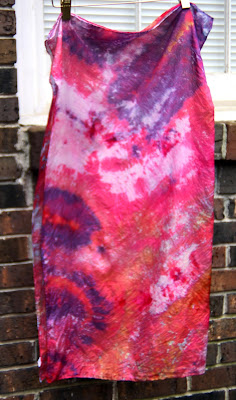 |
Tank top 2- the red held it's own with the barrage of turquoise, navy and celadon.
Tank top 3- this one had the most of the green that went yellow, as well as some palomino gold, which interestingly did not turn green.
LESSONS LEARNED-
I wash a load right after these and they seems to have turned a bit blue. So it is either that my HE washer did not drain all of the water thus depositing, or I remember that I did not re-mix the soda ash mix, which is in it's third use, so it is possible that the chemical reaction was not as strong and more dye released than expected.
~ So, mix the soda ash well
~ Perhaps only use it two times, or replenish
~ Only wash darks after a dye load
~ Try those "color catchers" from Shout
Let me know what you think!




























